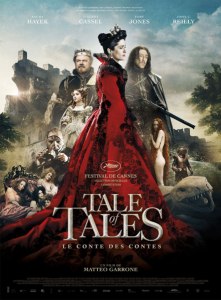 Near the beginning of “Tale of Tales” a slender, cloaked old man slinks his way into the palace of the King and Queen of Longtrellis (John C. Reilly and Salma Hayek) to bestow upon them a prophecy. The Queen is desperate to have a child, and she agrees to the specter’s challenge: “Hunt a sea monster, cut out its heart, have the heart cooked by a virgin, she must be alone, then eat the heart, and you will become pregnant.”
Near the beginning of “Tale of Tales” a slender, cloaked old man slinks his way into the palace of the King and Queen of Longtrellis (John C. Reilly and Salma Hayek) to bestow upon them a prophecy. The Queen is desperate to have a child, and she agrees to the specter’s challenge: “Hunt a sea monster, cut out its heart, have the heart cooked by a virgin, she must be alone, then eat the heart, and you will become pregnant.”
The man’s instructions are so oddly specific and strange as to produce a chuckle, but the prophecy is told with the gravest of importance. Such is the tone in Matteo Garrone’s “Tale of Tales,” a contender for one of the more bizarre movies of the year, if not the decade, but also a satirical edge to dull the gravity of its bloody and strange fantasy. The Italian director’s English language film adapts fairy tales by Giambattista Basile to weave together three stories of attachments, vices, and the harsh lessons learned by those corrupted by power.
The first story involves Hayek’s queen, who after gnawing away at a gory hunk of a sea monster’s heart, becomes pregnant and gives birth to an albino son who resembles the sea monster that killed the King. But born on the same day to the virgin cook is an identical twin. As teenagers, the boys form an inseparable, brotherly bond. The Queen hopes to separate her son from this peasant and ends up driving her son’s twin away.
In the second, a womanizing, sexual demon of a king (Vincent Cassel) hears a woman singing in town and pursues her, unaware that the voice belongs to one of two decrepit old hags (Hayley Carmichael and Shirley Henderson under pounds of makeup) hoping to deceive him. Finally, a third king (Toby Jones) begins raising a flea until it is the size of a small elephant. His attachment to his pet distracts him from the needs of his maturing daughter the Princess (Bebe Cave).
From the flea with bulging, alien eyes to the wrinkled old ladies to the underwater sea monster, everything within “Tale of Tales” has an artificial quality. One shot has Cassel stepping over a grotto full of lounging nudes, as though we’ve walked into a Renaissance painting and can now witness the seams up close. And yet the film is alive with colors and rich, painterly landscapes; note the incredibly detailed and craggily blue mountain range surrounding the sea monster’s lair, the overhead shot of a hedge maze or the blooming greens surrounding the red hair of a forest nymph.
The film’s look is instrumental in allowing Garrone to wink at the camera and provide a sense of self-aware goofiness and outrageousness running through these dour fables. In each he proves that taking these stories literally produces garish, outlandish results and horrifying consequences to the characters at the center. And the film’s cartoonishly bloody nature makes for a film that’s equal parts hilarious and mysterious.
Films as weird as “Tale of Tales” only come around once in a blue moon, and Garrone’s satirical handling of the film’s visual splendor helps make the fairy tale indelible. There’s just no happily ever after here.
4 stars
